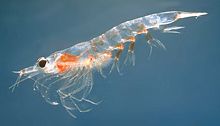Eucarida adalah sebuah superordo dari Malacostraca, subfilum krustasea yang terdiri dari dekapoda, krill, dan lainnya.[2] Mereka dicirikan dengan memiliki karapaks yang menyatu dengan seluruh segmen toraks, dan memiliki mata yang bertangkai.[3]
Filogeni
Filogeni Malacostraca masih diperdebatkan.[4] Secara khusus, monopoli Eucarida juga dipertanyakan:
- Monofiletik: banyak yang berpendapat bahwa kelompok Eucarida adalah sebuah klad, saudara dari klad Peracarida[4][5] atau ke basal Malacostraca,[6][7] atau ke Mysida (Schizopoda parafiletik)[8]
- Parafiletik: beberapa ahli mengusulkan Eucarida parafiletik yang membentuk klad dengan Peracarida yang bersarang.[9]
- Polifiletik: beberapa ahli mengelompokkan Euphausiacea dengan Mysida untuk membentuk Schizopoda,[10][11] atau Euphausiacea dengan Hoplocarida,[12] dengan basal Decapoda di Peracarida.[11][12]
Referensi
